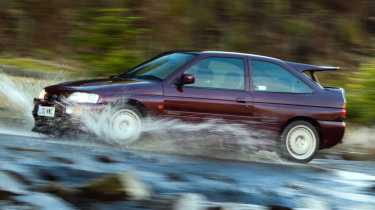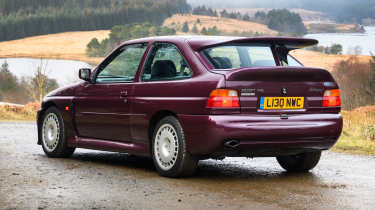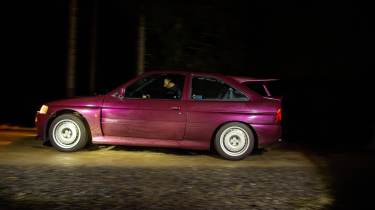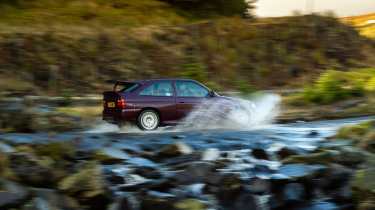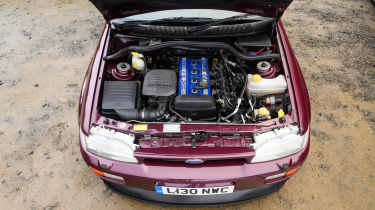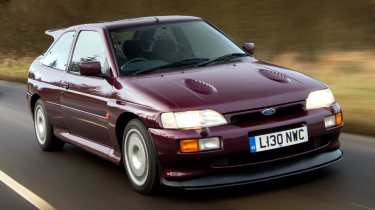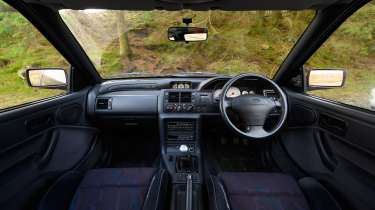Ford Escort RS Cosworth (1992 - 1996) – history, review and specs of Ford's rally star
It was a poster car for a generation and the ‘Cossie’ now has a cult following
The Ford Escort RS Cosworth is now over 30 years old, and in the ensuing decades since its launch it’s been a Group A rally legend, a joy riders delight, a getaway driver’s dream and is now a seriously sought after usable modern classic. Many of those that lusted after the Cossie when it was new are now old enough, and importantly well-heeled enough, to appreciate them first hand. 1990s cars are all the rage, and a used Ford Escort RS Cosworth is a major nostalgia-inducing machine for avid followers of the golden age of rallying and fast Ford fans alike.
For this reason, its dated looks are paradoxically now quite refreshing – its combination of striking oversized wings and wide-body stance with that iconic whale-tail rear wing and spoiler stuck onto the otherwise mundane ordinariness of the Escort Mk5 is representative of the era that conceived it. It’s the era of the Lancia Delta Integrale, Mitsubishi Lancer Evo and Subaru Impreza Turbo, epitomising the ethos of ‘win on a Sunday, sell on a Monday’.
The standard Escort’s platform (front-wheel drive with a transverse engine) wasn’t really the best for Ford to start with given the rally homologation requirements. Its rivals, from the aforementioned Japanese trio to the Lancia Delta Integrale, had been developed from the ground up with crucial all-wheel-drive drivetrains in mind, and refined from thereon.
Ford did have an ace up its sleeve, and in 1988 Stuart Turner, then head of Ford Motorsport, had convinced those around him that it would be a good idea to take the platform and running gear from a prototype Sierra Cosworth 4x4, chop a bit out of the middle and put the bodywork of an Escort RS Turbo around it. Instantly it was brilliant.
More reviews
Executives from Ford took it for a thrash up and down the A12 and loved it but, because the next generation of Escort was planned to be front-wheel drive with transverse engines, Turner et al were told to think of something more sensible. Thankfully, after much perseverance from Boreham, the Escort RS Cosworth eventually got the go-ahead. The project was designated ACE14 (A for Group A, and CE14 being the code for the new Mk5 Escort) and the prototype was known simply and affectionately as Ace.
The familiar 2-litre turbocharged engine also saw tweaks – in went a new Garrett T35 turbocharger and a two-stage intercooler. In original form this developed 224bhp at 6250rpm and 224lb ft of torque at 3500rpm, figures dwarfed by those of even today’s Focus ST, but the big turbo meant big lag and then big boost, for a startlingly exciting power delivery. Ford did tone this down a little with a smaller T25 turbocharger in 1994, and peak power dropped by 10bhp. Those early cars are more tuneable, the latter more driveable in standard form.
What we said
‘Inside, the Cossie feels narrow, small, airy; it smells of the 1990s, somehow – an impression enhanced by the ghoulish glow of the backlit instrumentation and the separate DIN-slot CD player below the main hi-fi unit. The YB engine cranks into life with a growl and a tremor, the original ’80s lager-swilling bad boy motor as uncouth as ever.
‘The engine is amusingly flat below 3500rpm, as in completely devoid of any enthusiasm whatsoever. I just can’t imagine what buyers today would think of its contrary slothfulness, just as I adore its authenticity; it just doesn’t give a proverbial what you or I think, reinforced by the belligerence of that rear wing and the mother and father of all daisy cutters below the front PU.
‘The seats are good, though. No-nonsense items that hold you firmly in place, albeit mounted high. The ugly airbag wheel feels small in the hands, and it’s rapidly clear it needs little in the way of input to have a very big influence on where the front end is pointing, which in turn makes for a lively rear that’s exaggerated by notable body roll.
Already I can sense the Cossie is a live wire, and when the opportunity presents itself to keep the throttle wide open for long enough, its punch is keener than merely 217bhp suggests.’ – Adam Towler, evo 271
‘Despite four-wheel drive, the Cossie has a hot hatchback-like feel: all front-end bite with a playfully mobile tail. The combination of a super-pointy front end and 33/67 front/rear torque split is a clever and expressive one.
It allows you to set the car up on the way into a corner, turning in with a deliberate lift of the throttle to get the tail moving, then using the quick steering and rear-biased torque split to power through. It’s something you need to reserve for open, clearly sighted corners, but it’s a treat you’ll never tire of.
‘It's not everyone's cup of tea, and there's no question the car's humble origins and four-cylinder engine lack the kudos of a more exotic body and a sweet-spinning six-cylinder, but the Escort Cosworth is a vivid reminder of the days when rallying still gave us exciting road cars.’ – Richard Meaden, evo 157
Ford Escort RS Cosworth buying guide
Mechanically, there’s nothing much here that should scare you: four cylinders, 16 valves and a turbocharger. Knowing what you’re getting is important though.
Earlier (pre-94), big-turbo cars feature what’s known as a ‘YBT’ engine, most easily identifiable by the blue cam cover. Later, small-turbo engines are known as YBP units, and are denoted by a smoother, silver-finish cam cover. Big turbo versions can be easily tuned but the later cars will take big money to take them over 300bhp.
High states of tune can affect reliability, so if the car you’re looking at has big power claims then exercise caution. Otherwise, it’s mainly routine checks: excessive oil leaks, coolant leaks (pointing to head gasket failure), and on the test drive, excessive amounts of smoke – blue points to oil issues (piston rings under load, or turbos on the overrun), white again points towards the head gasket. Check the coil and plugs, too, as both can cause rough running.
All cars got a MT75 five-speed manual gearbox and sent their power to all four wheels. Like the engine, everything here is fairly hardy, but put more power through it and wear will be accelerated, eventually (or quickly, depending on the output) resulting in failures. Synchro rings can fail, too, but the ’box isn’t as slick as a modern one anyway, so you’re looking for crunching and difficult gear engagement, rather than obstinance. Make sure it doesn’t whine in second or third gear as this is an indicator of a ‘box living on borrowed time.
Many older cars are under-braked by modern standards and the Escort Cosworth is little different. Most will have been upgraded by now so the old problems of warped discs may no longer be present (except for on the most original examples), but as a performance car there may well be signs of hard use, so check how much meat is left on the discs and the pads and use that as a bargaining point.
Calipers can stick, especially at the rear, but the ABS is generally fault free – if there’s a problem with the system it’s most likely dirty or faulty wheel sensors.
Likewise, springs or dampers may well have been upgraded by now, but a test drive will reveal any other suspension issues, such as perished bushes or tired dampers.
Most Cosworths are now prized, either as collector vehicles or trackday hacks, and as such most should be visually and structurally good – at least at a glance. Rust is always a problem on old Fords but should be uncommon on well-loved examples, so treat it as a sign that other maintenance may too be being neglected.
Rust can attack the floorpan, bulkhead, rear chassis rails, strut and spring mounts and the rear wheelarches. Most panels (bar the doors roof and pillars) are unique to the Cosworth so are expensive to replace. Chassis damage is also always a possibility – Cosworths tend to be driven enthusiastically – but again, a well-maintained car should have had this corrected professionally.
Interiors are standard 1990s Ford fare – very much not a haven of soft-touch plastics and high build quality – but should still be nicer, and better maintained than a bog-standard Escort cabin. The original Recaro seats may be looking a bit tired by now, if the owner hasn’t replaced them with buckets for track work.
Trim pieces can be hard to come by – especially the white-faced dials which can discolour with age – even though many are from standard Escorts of the era. Cars with the Luxury pack have cloth Recaros, electric windows, opening rear windows, a heated screen and for 1993 and 1994 an electric sunroof. Leather Recaros were an option.
Ford Escort RS Cosworth specs
| Escort RS Cosworth (YBP, 1994-1996) | Escort RS Cosworth (YBT, 1992-1994) | |
| Engine | In-line 4-cyl, 1993cc, turbocharged | In-line 4-cyl, 1993cc, turbocharged |
| Power | 217bhp @ 6250rpm | 224bhp @ 6250rpm |
| Torque | 214lb ft @ 3500rpm | 224lb ft @ 3500rpm |
| Transmission | Five-speed, manual, four-wheel drive | Five-speed, manual, four-wheel drive |
| Tyres | 245/45 ZR16 front and rear | 245/45 ZR16 front and rear |
| Weight | 1320kg | 1275kg |
| Power-to-weight | 167bhp/ton | 179bhp/ton |
| 0-62mph | 6.1sec | 6.2sec |
| Top speed | 136mph | 137mph |
| Price | £26,750 (1995) | £20,524 (1992) |
What to pay
Despite its humble Ford origins, the Cossie wasn’t built in the numbers normally associated with the brand – just 7145 were made. As a result, finding a standard Escort Cosworth is quite a challenge these days, and the degree to which an example is standard, original and low on miles hugely influences the price you should expect to pay.
Some prospective purchasers might like the idea of a Cossie with 400bhp and a host of non-standard parts but the market doesn’t tend to agree. Prices start at around £35-40k for higher mileage modified examples, £50k should bag a standard example with higher miles with £65,000-£75,000 needed for very good lower mileage examples. Ultra low-mileage machines can command prices of over £150k with the world record price of £202,500 being set for a 1992 2000-mile Lux model at the tail end of 2024.
